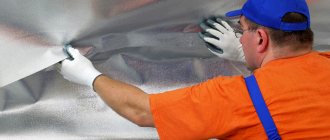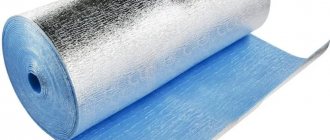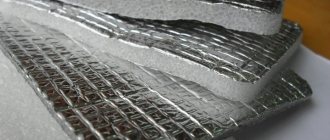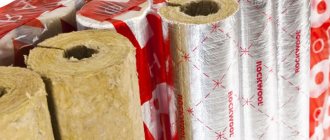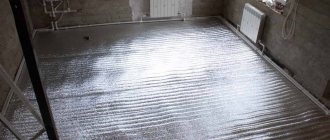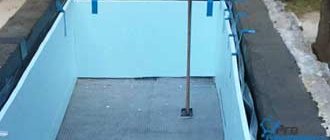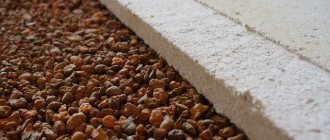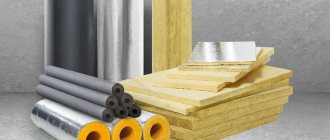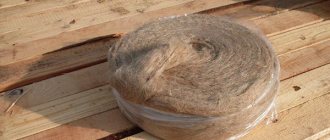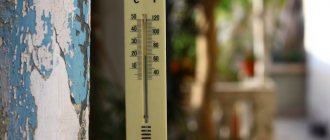Penofol foam insulation, equipped with heat-reflecting foil, is included in the product range of the domestic company Zavod LIT. The popularity of the material is evidenced by the fact that in everyday life Penofol is often referred to as analogues of other brands that are identical in characteristics.
- Structurally lightweight, affordable and efficient in operation, the insulator consists of a foam polymer base with a thickness of 3 to 10 mm, as well as a one- or two-sided metallized coating.
- More than 30 Russian companies specialize in the production of similar materials, however, Penofol consistently maintains high ratings.
- The scope of application of insulation, which is universal in many respects, includes in its list the thermal insulation of residential, industrial and special purpose objects.
- Penofol in various modifications is in demand in technologies for thermal insulation of pipes and ventilation lines, ice surfaces of sports complexes, thermal circuits of private houses and city apartments.
Analogues of Tepofol are similar materials from the trademarks TILIT, TITANFLEKS, ARMOFOL and a number of others.
Actually, Penofol itself is identified by the blue color of the polymer foam base and the presence of holographic logos on the metallized coating. Models with indexes A and B are distinguished by one or two-sided foil. The design feature of Penofol S is an adhesive mounting layer covered with a polymer film.
In the building materials market, cheaper and low-quality analogues of counterfeit assortment are often sold under the logos of well-known brands. It is safest to buy Penofol or its analogue Tepofol in a company store or at the sales office of a large construction company.
Installation and operational characteristics
The material demonstrates:
- low thermal conductivity and stability of initial parameters in the temperature range from -30 to +90 degrees Celsius;
- resistance to moisture, adverse mechanical, chemical and biological influences, as well as sudden temperature changes;
- high, up to 90% coefficient of reflection of thermal radiation.
In particular, a 5 mm thick polymer foam heat-protective lining is identical in heat retention to a ten mm mineral wool analogue. The low vapor permeability of Penofol allows you to reduce the cost of insulation work by eliminating film or membrane vapor barriers. The material is produced in roll packaging with a web width of 1000 mm, thickness from 3 to 10 mm.
The foam polymer coating is safe in terms of fire protection, since under the influence of fire it does not support combustion, but melts with the release of a small amount of carbon dioxide. The insulation is fully compatible with mineral, metal and organic substrates. Installation technology allows the material to be laid on both sides of building structures.
How to insulate with penofol
It should be noted that insulating anything (a wall, ceiling or roof) with penofol is really quite simple. If you follow the manufacturer's instructions, then to achieve maximum efficiency it is necessary to provide an air gap of 1.5 to 2 cm wide on both sides. To create such a gap, rolled penofol will have to be attached to wooden sheathing strips attached to the base.
That is, first you need to take 20 mm thick planks and attach them to the wall vertically or horizontally at intervals equal to the width of the penofol roll. If the house is wooden, then the planks are fastened with self-tapping screws; for brick or concrete bases, dowels will be required. Then strips of the required length are cut from the roll and attached to the planks with staples from a construction stapler.
Important. Unlike various thin films, the installation of penofol sheets is carried out not overlapping, but end-to-end. In this case, the foil side should be facing inside the room, and the joints should be carefully taped with aluminum tape.
When the layer of thermal insulation made of penofol is fixed and taped, the same strips are installed on top of it with your own hands to provide an external air gap. They are attached with self-tapping screws to the previous sheathing, and the outside is lined with plasterboard sheets or other finishing methods are used. Please note that a vapor barrier film is not laid, since there is no need for it; penofol itself is a vapor barrier.
It must be said that in practice, few people follow the instructions; usually penofol is attached directly to the wall or ceiling, and the air gap is made only on one side. This reduces the thermal insulation properties of the material, and further we will tell you why. When thermally insulating roofs or inclined walls of attics, installation of penofol is carried out by attaching it to the lower planes of the rafter boards. This means that the space between the rafters is filled with other insulation, since thin polyethylene alone will not be enough.
Important. If penofol can replace a vapor barrier, then under no circumstances can it replace waterproofing. You cannot lay it in the under-roof space in front of mineral wool; a diffusion membrane is needed there. It does not allow water to pass through, but also does not prevent the passage of vapors escaping from the cotton wool.
Floors in wooden houses are also insulated with foamed polyethylene, laid between the joists. Again, waterproofing is laid first, then slab insulation, and penofol on top. Putting it at the very bottom or in the screed is pointless; compression causes the material to cease to be heat-insulating. Although in practice such errors can be encountered often.
Another area of application of penofol is the insulation of balconies and loggias, where the material is laid as a second layer after more serious insulation materials - extruded polystyrene foam or polystyrene foam. The installation method is still the same: first, the sheathing bars are placed, polystyrene slabs are laid between them, and polyethylene foam is attached on top. After this, interior finishing is carried out.
Note. Perforated penofol is used as insulation for the walls of a wooden house in cases where it is necessary to ensure vapor permeability of the structure.
Table of characteristics of foil Penofol
| Options | Type - A | Type - B | Type - C |
| Applicable at temperature, °C | -60 to +100 | ||
| Surface thermal reflection coefficient, % | 95 — 97 | ||
| Thermal conductivity coefficient, dry, at 20 °C, no more | 0,037 — 0,049 | 0,038 — 0,051 | 0,038 — 0,051 |
| Water absorption by volume,% | 0,7 | 0,6 | 0,35 |
| Vapor permeability, mg/m h Pa | 0,001 | ||
| Ultimate compressive strength, MPa | 0,035 | ||
1 Advantages and features of the material
The main advantages that distinguish this foil insulation from other wall insulation products available on the market are the following:
The effectiveness of the thermal insulation coating of the underlying penofol, namely foamed polyethylene, is so high that penofol, the thickness of which is about 2-3 centimeters, guarantees insulation of better quality than similar heat insulators up to 8 centimeters thick.
This advantage makes it possible to rationally use penofol to insulate the walls of the smallest rooms - this insulation will not “eat up” a large amount of usable space.
An example of penofol insulation of a loggia
Insulation is not the only function that penofol performs. The structural features of this material give the insulation additional vapor barrier and sound insulation properties.
The ability of penofol to effectively dampen sound will be appreciated by those people who live near railways, highways, or simply in the center of a large and noisy city.
In fact, insulating walls with penofol replaces at least 3 insulating layers: a waterproofing coating of the walls that protects them from dampness and blooms, a membrane coating for vapor barrier, and classic insulation.
- Wide temperature range.
This insulation will effectively perform its functions when temperatures fluctuate from -60 to +110 degrees, while even sudden temperature changes do not cause a loss of performance characteristics of foil foam.
Penofol has good elasticity, which is why it can be used not only to insulate walls, but also pipes, corners of rooms, and other shaped elements. The minimum weight allows you to install the insulation without the need for a supporting frame or a complex fastening system.
At the same time, no special equipment is required to insulate a house with foil penofol - it can be cut without problems with ordinary scissors, and the effort of one person is enough to attach the insulation to surfaces.
Thermal insulation of ventilation ducts using penofol
Penofol does not have any negative effect on the human body; it is perfect for thermal insulation of walls both outside and inside the room.
Perhaps, among all the advantages of foil penofol, in practice most attention is paid to the adequate price. Statistics show that covering the floor or walls of a house with penofol will be approximately 2-3 times cheaper than any other insulation.
Moreover, if you consider that you will not need any other materials, such as wooden beams for the frame, or an additional layer of waterproofing for the walls, then the benefit of insulating the house with penofol becomes obvious.
It is also important that, at a lower cost, the technical characteristics of penofol are comparable and sometimes exceed those of other thermal insulation materials.
1.1 Disadvantages of the material
This insulation is not without disadvantages similar to those of Penoflex insulation, which relate more to the features of its design than to the properties of the material itself.
Comparative table of Penofol with other insulation materials
| Material | Required thickness |
| Penofol type B, installed with two air layers | 4 mm |
| Clay brick | 672 mm (2.5 bricks) |
| Silicate brick | 840 mm (3.5 bricks) |
| Expanded clay concrete | 490 mm |
| Aerated concrete | 384 mm |
| Mineral mats | 67 mm |
| Expanded polystyrene | 46 mm |
Varieties
See also
Starter strip for siding and panels: how to install correctly
In addition to the type of coating made of foil or sprayed metal, tepofol is divided into several categories.
- Type
A. This is a rolled material made of foamed stitched polyethylene. On one side it is covered with a metallized film. Suitable for pitched roofs, ceilings, walls, floors and attics. Can be used as a reflector for heating radiators. Tepofol type A is also used to insulate pipes; - Type
B. There is a double-sided reflective layer in the form of aluminum foil. There is polyethylene foam between them. This structure provides maximum protection against heat loss. Used for insulation of floors, walls, pipelines. They also install air ducts, an attic, and a roof. And not only for heat protection, but also for noise and moisture protection; - Type
C. The structure includes a metallized film, polyethylene foam, an adhesive layer and a protective coating. Can be used on roofs and attics. It insulates well and protects walls from noise and moisture. Can be used in baths and saunas.
Based on what needs to be isolated and where, you can select the appropriate type of tepofol.
Tepofol
The material is a roll insulation based on non-crosslinked polyethylene foam with interlocking joints and interfaces. The insulation, universal in many respects, was developed by the design bureau of the company of the same name, which also designed inexpensive and productive equipment for laminating polymer foam materials.
At this time, the company has the status of the only manufacturer in the country and the world of rolled thermal insulation with a heat-reflecting component 50 mm thick.
Bestsellers of Tepofol insulation
Quick view
Polyethylene foam Tepofol S-03 foil self-adhesive
Quick view
Polyethylene foam Tepofol NPE A-08 foiled
Quick view
Foamed polyethylene Tepofol NPE 5 mm
Quick view
Tepofol B 2 mm double-sided metalized
Consumer reviews of Tepofol varieties
"Tepofol", reviews of which are often only very positive, are offered for sale in several varieties. Each of them is designated by a specific letter, which indicates quality characteristics. According to users, under the letter A, the manufacturer produces Tepofol with a reflective coating, the last of which is aluminum foil. Sometimes it is replaced with a polished metallized film.
Consumers quite often choose Tepofol insulation, which is designated by the letter B. It has a double-sided coating of aluminum foil and metallized film. As users emphasize, self-adhesive material is designated by the letter C. By the way, it has an aluminum coating on one side and a metallized film on the other. On sale you can find “Tepofol”, which is called “Metal”. In this case, a metallized film is used as a reflective layer. If necessary, you can also purchase NPE. It is a backing made of foamed polyethylene.
Product overview
A characteristic feature of the branded insulation is the presence of a locking connection between the upper and lower edges of the roll.
Depending on the modification, the heat reflector can be metal foil or metallized lavsan film. The new generation material with a total thickness of 20-150 mm is aimed at providing basic thermal insulation for the interiors of residential and industrial facilities. For additional, including combined heat and sound insulation, Tepofol with a thickness of 2 to 10 mm is used.
Penofol brand affiliation
The new generation of thermal insulation material is part of the product range, which for the first time in Russia offered lightweight insulation made of porous polyethylene, equipped with a heat-reflecting metallized coating. This may be why, in everyday life, Penofol is the name for any polymer-based foil insulation.
- Closed gas-filled cells with a diameter of up to 2 mm provide the material with flexibility and elasticity, while at the same time imparting nominal resistance to mechanical loads.
- Penofols of categories A and B, respectively, with one-sided and double-sided foil, insulation with index C is additionally equipped with an adhesive mounting coating.
It should be noted that more than 30 companies specialize in the production of Penofol analogues in the Russian Federation. A separate segment is represented by cheap, environmentally unsafe and identical heat insulators of unknown origin, which are often sold under the brand name of leading domestic and European brands.
Installation features
The insulation has positively proven itself in a wide range of construction and repair and restoration technologies Tepofol demonstrates the advantages of fast, uncomplicated and productive installation, compliance with design requirements for thermal insulation of industrial premises, warehouse hangar storage facilities - frame, frameless and tent types, private houses and city apartments.
Attention! Tepofol is produced with foil and metalized coating. The cost and scope of application of these products vary. Carefully study the information before purchasing or contact our experts for help!
Feedback on features of use
If you decide to use Tepofol for insulation of various structures, it is recommended to read reviews about the material in advance. Perhaps this will avoid many mistakes. From them you can understand that Tepofol is universal and has a wide range of models. The material can be used in residential and industrial construction, for thermal insulation of equipment and pipelines. This insulation is used as a base for the floor covering of a heated floor system.
If you lay the material with the reflective side facing the covering layer, you will be able to protect the premises from overheating in hot weather. "Tepofol", which has only the most positive reviews from employees, must be installed using a special glue or self-adhesive layer. If we are talking about a double-sided product, then it must be fixed to the frame structure with staples or nails. It is possible to use insulation even in rooms that are operated in conditions of high humidity. Consumers are advised to use metallized tape to waterproof joints, which does not allow the reflective layer to be interrupted.
Self-selection criteria
What is better Penofol or Tepofol? Judging by this review, the performance properties of both insulation materials do not differ significantly, and the price of a 25-meter roll ranges from one and a half thousand to 1,800 rubles. The difference between Penofol and Tepofol is also the possibility of sealing Tepofol installation joints with hot air from a hair dryer.
By choosing one of the insulation materials, the Baustov company guarantees you that you will win in any case, since both insulation materials have equal effective heat saving and a long service life.
Call! We will calculate for FREE
8
Head of Sales Department
